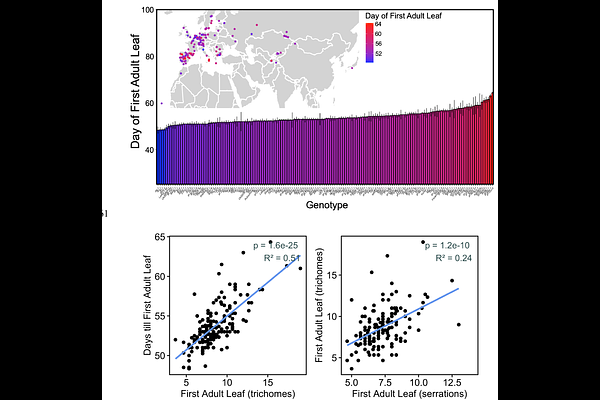It's all in the timing: vegetative phase change alters selection under drought and contributes to local adaptation

It's all in the timing: vegetative phase change alters selection under drought and contributes to local adaptation
Lawrence-Paul, E. H.; Janakiraman, J.; Lawrence-Paul, M. R.; Ben-Zeev, R.; Penn, A.; Lasky, J. R.
AbstractThe timing of developmental transitions is critical for environmental adaptation, allowing organisms to align stress tolerant and sensitive stages with harsh and benign periods, respectively. This timing across seasons (i.e. phenology) is often under spatially-varying selection across climate gradients, and species often exhibit genetic clines in phenology. Clines for transitions like germination and flowering time are well documented; less is known about the juvenile-to-adult vegetative phase change (VPC) - a conserved (among plants) yet visually subtle developmental transition marked by changes in leaf morphology and physiology. Alternatively, developmental tradeoffs can reduce fitness differences between genotypes and promote diversity within populations. Here, we tested 158 diverse genotypes of Arabidopsis thaliana under drought during either the juvenile or adult vegetative phases along with well-watered controls. We measured performance, physiology, and timing of developmental transitions. We found strong rank-changing genotype-environment interactions with fitness depending on the stage at which drought occurred, indicating tradeoffs and distinct mechanisms of drought adaptation between different stages. Fitness reductions were generally greater under juvenile drought, suggesting that the juvenile phase is more vulnerable than the adult phase to stress. Adult plants significantly increased water use efficiency in response to drought but juvenile plants did not, consistent with earlier results showing reduced plasticity in the juvenile phase. Genome-wide association mapping revealed candidate loci for the timing of VPC and stage-specific drought responses. Globally, VPC timing was weakly related to climate but in Iberia there was a significant trend of early VPC in seasonally dry climates and late VPC in moist climates. Analysis of global geographic variation in putative QTL showed a strong depletion in SNPs associated with the timing of VPC and juvenile drought fitness, suggesting variation in these loci is maintained within populations due to consistent tradeoffs all across Arabidopsis range. These results demonstrate that the timing of VPC contributes to adaptive responses to drought and that tradeoffs across developmental stages help maintain genetic diversity in natural populations.